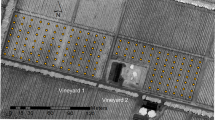Abstract
Soil cohesion changes with the moisture state of a soil. This paper presents an empirical equation to predict the cohesive component in the shear strength of unsaturated residual soils as an exponential function of volumetric water content. The formulation originated from a multiple linear-regression analysis for data sets obtained from shear tests using undisturbed soils with varying moisture contents. The empirical equations can realistically predict the reduction in soil cohesion due to wetting (R 2=0.88, 0.93). The methodology described in this paper provides a convenient alternative to the quantitative estimation of unsaturated shear strength, especially in an engineering practice such as a slope stability analysis as no matrix suction data are required.
Résumé
La cohésion des sols change avec leur teneur en eau. L’article présente une relation empirique permettant d’exprimer la valeur de cohésion de sols résiduels non saturés comme une fonction exponentielle de la teneur en eau volumétrique. La formulation résulte d’une analyse par régression linéaire de séries de données provenant d’essais de cisaillement sur des sols non remaniés présentant diverses teneurs en eau. Les équations obtenues sont capables de représenter correctement la diminution de la cohésion résultant de l’humidification d’un sol. La méthodologie présentée dans l’article permet d’obtenir une estimation de la résistance au cisaillement en conditions non saturées, en particulier pour des applications relatives à des analyses de stabilité des pentes, sans faire appel à des données concernant l’état de succion du sol.




Similar content being viewed by others
References
Bishop AW (1959) The principle of effective stress. Teknisk Ukeblad 39:859–863
Escario V, Sáez J (1986) The shear strength of partly saturated soils. Géotechnique 36:453–456
Fredlund DG, Morgenstern NR, Widger RA (1978) The shear strength of unsaturated soils. Can Geotech J 15:313–321
Fredlund DG, Xing A, Fredlund MD, Barbour SL (1995) The relationship of the unsaturated soil shear strength to the soil–water characteristic curve. Can Geotech J 32:440–448
Gan JKM, Fredlund DG, Rahardjo H (1988) Determination of the shear strength parameters of an unsaturated soil using the direct shear test. Can Geotech J 25:500–510
Khalili N, Khabbaz MH (1998) A unique relationship for χ for the determination of the shear strength of unsaturated soils. Géotechnique 48:681–687
Kim J, Jeong S, Park S, Sharma J (2004) Influence of rainfall-induced wetting on the stability of slopes in weathered soils. Eng Geol 75:251–262
Krahn J, Fredlund DG, Klassen MJ (1989) Effect of soil suction on slope stability at Notch Hill. Can Geotech J 26:269–278
Lee SJ, Lee SR, Kim YS (2003) An approach to estimate unsaturated shear strength using artificial neural network and hyperbolic formulation. Comput Geotech 30:489–503
Matsushi Y, Matsukura Y (2004) Mechanism and location of slope failures in hilly terrains with different bedrock permeability (in Japanese with English abstract). Trans Jpn Geomorph Union 25:139–159
Miao L, Liu S, Lai Y (2002) Research of soil–water characteristics and shear strength features of Nanyang expansive soil. Eng Geol 65:261–267
Öberg AL, Sällfors G (1997) Determination of shear strength parameters of unsaturated silts and sand based on the water retention curve. Geotech Test J 20:40–48
Rahardjo H, Lim TT, Chang MF, Fredlund DG (1995) Shear-strength characteristics of a residual soil. Can Geotech J 32:60–77
Rao SM (1996) Role of apparent cohesion in the stability of Dominican allophane soil slopes. Eng Geol 43:265–279
Vanapalli SK, Fredlund DG, Pufahl DE, Clifton AW (1996) Model for the prediction of shear strength with respect to soil suction. Can Geotech J 33:379–392
Author information
Authors and Affiliations
Corresponding author
Rights and permissions
About this article
Cite this article
Matsushi, Y., Matsukura, Y. Cohesion of unsaturated residual soils as a function of volumetric water content. Bull Eng Geol Environ 65, 449–455 (2006). https://doi.org/10.1007/s10064-005-0035-9
Received:
Accepted:
Published:
Issue Date:
DOI: https://doi.org/10.1007/s10064-005-0035-9




